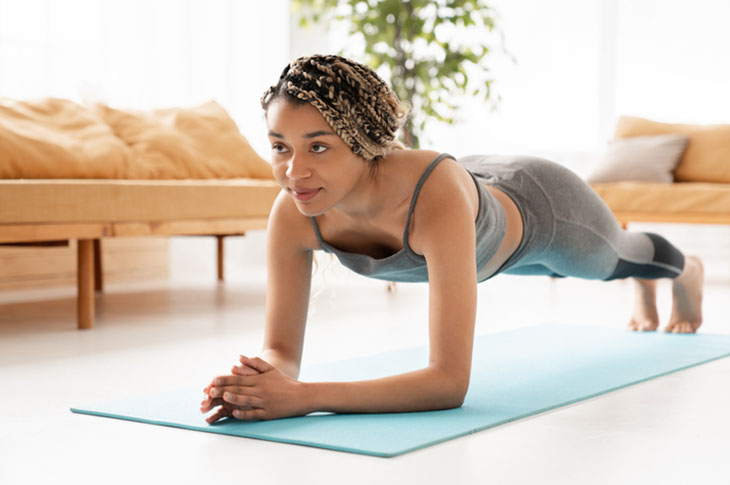
Before the pandemic, gym memberships were at an all-time high. Now, not so much. “Even though things have begun to return to some degree of normalcy and gyms have started to reopen, many people have grown to enjoy the privacy and convenience of [working out in] their own homes,” says Karen Smith, NASM-CPT, a bodyweight strength specialist and certified trainer. The result? Many exercisers have no intention of going back to the gym.
Could an at-home bodyweight training program work for you? Here’s what the experts have to say, plus a 9-minute routine to get you started.
The benefits of bodyweight training
“Bodyweight training is the ultimate convenience, allowing you to train anytime, anywhere,” says Smith. “Often, people only think of calisthenics and cardio-type moves, but the options for strength and conditioning are endless.” All it takes is a small corner of space and about 15 minutes, no special equipment required.
If you think working out at home is a step down from the weight room, some trainers beg to differ. “Weightlifting is a good tool, but it requires coaching and tends to make people stiff and unathletic,” says Mark Lauren, co-author of Strong and Lean: 9-Minute Daily Workouts to Build Your Best Body. “In the 15 to 20 minutes it takes to drive to the gym, you could have already done an effective, at-home bodyweight routine for a better all-around workout that boosts metabolism and improves strength, mobility, and endurance.”
Ready to give it a try? Lauren’s 5-move routine can get you started.
Move 1: Warm-Up. Get your heart pumping by marching in place for 60 seconds.
After warming up, do moves 2-4 for 45 seconds each, followed by 15 seconds of rest. Repeat 3 times:
Move 2: Parallel Leg Crunch. Lie on your back with your legs elevated and your hips, knees, and ankles bent at a 90-degree angle (your knees should be over your hips, and your calves should be parallel to each other). Inhale and reach upwards with both arms as high as possible.
Open your arms over your head so that your body forms a Y. Maintaining this position, exhale and slowly lower your arms backward toward the floor, stopping just before they are about to touch it. Then, reach your arms up, toward the ceiling, exhaling forcefully so that your abdominals contract.
Move 3: Low Drop. Start in a plank position on your forearms. Place your feet hip-width apart. Roll your heels all the way to the left, and transition to a left-side plank position with your right hand on your hips. Inhale and lower your hips to the floor. Exhale and raise your hips off the floor. Make yourself straight, tense your glutes, lift your chest slightly, and tighten your abs. Switch back to a plank on both forearms before switching to the right side. Repeat on the right side.
Move 4: Bottom Squat. Begin in a kneeling position with your arms straight out in front of you so that they are parallel to the floor. Inhale and step forward with your left leg so that it is at a 90-degree angle to the floor and you are still kneeling on your right knee. Then exhale and bring your right leg forward so that you are in a squat position with both your feet parallel to one another and your knees are pointing straight ahead. Keep your hips low and your chest up.
Inhale and reverse the movement by first stepping backward with your left leg and lowering your left knee to the floor so that you are kneeling on it while your right knee is still at a 90-degree angle. Then, exhale and repeat with your right leg so that you are in a full kneeling position.
Move 5: Cool Down: A-Frames (six slow reps on each side). Begin in a push-up position. To stretch your hip flexors, bring your left foot up toward your left hand so that your left knee is near your left shoulder and is bent to form a 90-degree angle.
Next, transition to a calf and hamstring stretch by straightening your left leg out in front of you and flexing your toes. Come back to the starting position and lower your left forearm to the floor so that it is perpendicular to your left hip. Return to the starting position and repeat on the right side.
The post Bodyweight Training Becomes the Norm appeared first on Fitbit Blog.